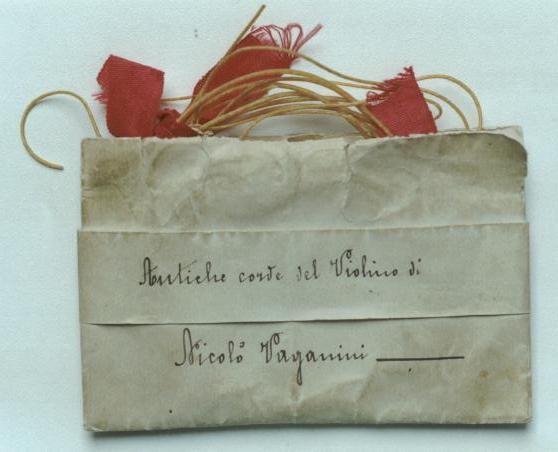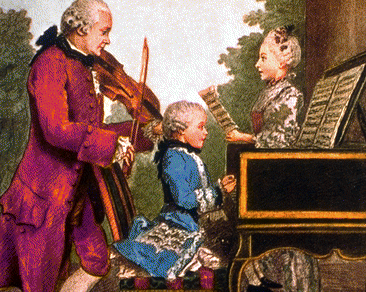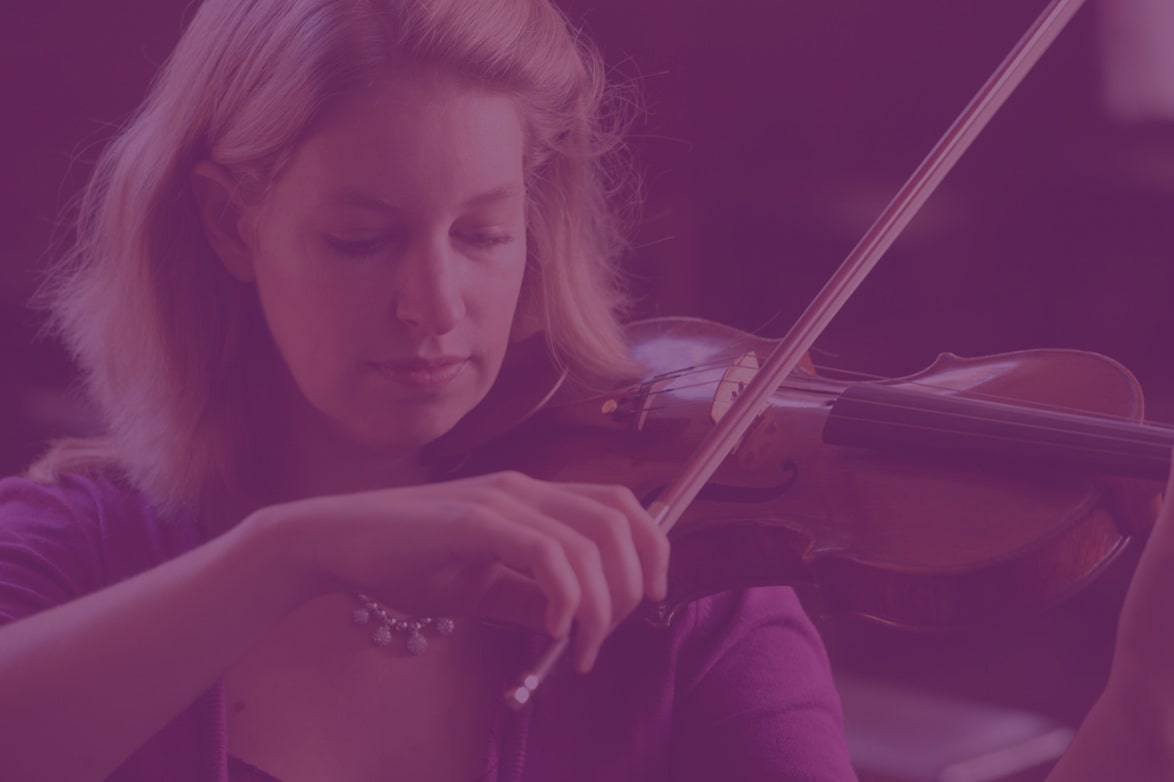
Research
Vibrato in the Romantic Era
This article is about different ways to use of vibrato in music from the Romantic period, for string players. Please take note that in this article by the word ‘vibrato’ is meant the device that we (modern day violinists) call vibrato: Producing a wavering pitch within the overall intonation of a note, using the left hand, arm or fingers. Older terms for vibrato (for example ‘close shake’, ‘ondulation’ or ‘tremolo’) were sometimes describing completely other kinds of vibrato as well, such as vibrato made by the bow. It goes too far for this article to describe and explain them all, so let us focus on what is called ‘intonational vibrato’ (with the left hand).
Between roughly 1750 and 1900, the use of intonational vibrato by string players (and other musicians) was mainly ornamental in character. Approaches varied, of course, from school to school and from musician to musician. The recent aesthetic of a ‘continuous vibrato’ as a way of tone production was accepted not earlier than in the early decades of the twentieth century. Before that time, most of the famous string players and teachers were strongly against applying it too much, as will be illustrated by the quotes beneath, and in fact nowadays ‘continuous vibrato’ already is regarded as ‘old-fashioned’ again, as we are becoming more conscious of different performance styles: Fashion is changing direction again! Interesting to see that taste in the use of vibrato seems to come and go in waves, just like vibrato itself. In 1636 (!) for example, Mersenne (a famous lute player) describes that vibrato on the lute is used very little in his time, but ‘that its lack of popularity can be explained as a reaction against its overuse in former times‘. In this blog the particular ‘wave’ in application of vibrato during the Romantic Era is explained. If one likes to perform in an informed way, it’s good to acquaint yourself with the habits and thoughts from musical colleagues from those times.
Let’s start from the half of the 18th century onwards: from that time an important change in attitude towards ornamentation was taking place. A passion for more ornamentation appeared in many kinds of music. Vibrato was considered as a form of ornamentation, so as this attitude towards ornamentation shifted, the use of vibrato was shifting simultaneously. It is well possible that a long unembellished note would have been considered as ‘distasteful’ by the musicians from 1750 and that they preferred to use vibrato, if other ornaments where inappropriate.
Ornamented capital letter B, by Mauro Poggi, 1750
There is a famous comment in the first edition of Francesco Geminiani’s treatise (1751), where he states that violinists should introduce the ‘close shake’ (other word for vibrato) ‘as often as possible to make the sound more agreeable‘, often used by defenders of the continuous vibrato. This is not really trustworthy, because he also writes out an Adagio and marks where to place a close shake. It turns out that his idea of ‘as often as possible’ is only around 6 times. There is another comment in Geminiani’s book where he states: “Of holding a note. It is necessary to use this often; for were we to make Beats and Shakes continually without sometimes suffering the pure Note to be heard, the Melody would be too much diversified.” Moreover, there are no similar texts in other treatises during the next 150 years. Still, it could be that this attitude by Geminiani represents a final stage of an older aesthetic, giving way to a more nuanced style of performance in which fewer ornaments were preferred.
The fact that in the later (18th century) editions of Geminiani’s book this recommendation for a frequent use of vibrato is absent supports this. Interestingly, one of the violin students of Geminiani, Robert Bremner, who became a famous music publisher, disagreed with his teacher on the use of vibrato. Bremner’s Some Thoughts on the Performance of Concert Music, a preface to his publication of J.G.C. Schetky’s 6 Quartettos opus 6 (1777), makes clear his opinions. If vibrato is “introduced into harmony“, he writes, “where the beauty and energy of the performance depend upon the united effect of all parts being exactly in tune with each other, it becomes hurtful.” Bremner may have even used his publishing position to censor his teacher’s opinions. He republished Geminiani’s 1751 The Art of Playing on the Violin in 1777, but three passages were left out in the reissue.
Also the famous comment by Leopold Mozart (1756) that some musicians ‘tremble upon every note as if they had the palsy‘ can be explained by this older aesthetic. It seems that there was a growing rejection of excessive ornamentation, moving towards a new aesthetic in which simplicity, directness and naturalness was preferred over elaboration and artificiality. The influence of Rousseau could have reinforced this ideal.
In the 1790s, the Italian violinist Galeazzi writes about vibrato that it should ‘be entirely banned from music by anyone equipped with good taste‘. In 1811, the English violinist John Jousse writes a chapter on vibrato in his ‘Theory and Practice of the Violin’ with the curious heading “Of the Tremolo or Close Shake (it is become obsolete).” Also the famous cellist Bernhard Romberg tells about former times (probably 1780s, when he was younger) when “the close shake was in such repute that it was applied indiscriminately to every note of whatever duration. This produced a most disagreeable and whining effect, and we cannot be too thankful that an improved taste has at length exploded the abuse of this embellishment.“
Bernard Romberg (1767 – 1841), drawing by Franz Krüger
So, as a result, in the beginning of the 19th century almost all writers who mention vibrato are immediately accompanying it with the warning that it be used with great discretion. Some don’t even mention the subject, such as Reichardt’s treatise ‘Uber die Plichten des Ripien-Violinisten’ in which he described all skills necessary to play in an orchestra. It seems that (contrary to what most performers think about performance practice of Romantic repertoire) in the 19th century generally less vibrato was used than in the second half of the 18th century.
At the start of the Paris Conservatory, Rode, Kreutzer and Baillot almost certainly used vibrato sparingly. Their ‘Methode’ (1803) only describes a bow vibrato. It does not mention left hand vibrato. In his 1834 treatise, Baillot writes about vibrato that ‘if frequently used it would have the disadvantage of making the melody unnatural and depriving the style of that precious naivety which is the greatest charm of art and recalls it into its primitive simplicity“. Furthermore he warns the player to “avoid making a habit of vibration of the hand“. In many French methods from that time, vibrato is not even mentioned (Habeneck, Alard). Also in treatises by flutists and singers the same fashion seemed to have taken place.
Pierre Marie François de Sales Baillot (1771 – 1842)
In Germany, Louis Spohr also strongly warned against an overuse of vibrato in his Violinschule (1832). In his Violinschule, Spohr added a violin concerto by Rode which he completely marked with wave-like signs (slow big waves going to faster smaller waves and opposite), to indicate where he would recommend what kind of vibrato.
He writes: “Amongst the embellishments may also be classed the tremolo, and the changing of the fingers on one tone and on the same string. The singer’s voice in passionate passages, or when he forces it to its most powerful pitch, has a trembling, which resembles the vibrations of a strong struck bell. This, the Violinist can imitate very closely, as well as many other peculiarities of the human voice. It consists in the wavering of a stopped tone, which alternately extends a little below or above the perfect intonation, and is produced by a trembling motion of the left hand in the direction from the nut towards the bridge. This motion however be slight, and the deviation from the perfect intonation of the tone should hardly be perceptible to the ear. In old compositions the tremolo is indicated by points (. ) or by the word tremolo; in new compositions it is generally left to the performer. Avoid however its frequent use, or in improper places. In places where the tremolo is used by the singer, it may also advantageously be applied to the Violin. This tremolo is therefore properly used in passionate passages, and in strongly marking all the fz or > tones. Long sustained notes can be animated and strengthened by it: if such a tone swells from p to f, a beautiful effect is produced by beginning the tremolo slowly, and in proportion to the increasing power, to give a gradually accelerated vibration.“ Louis Spohr strongly influenced violin performance in Germany for more than 70 years.
Louis Spohr (1784 – 1859)
Even in 1905, The opinion of Spohr was cited at length in the Violinschule by Joachim and Moser, taking up more than half of their short section on vibrato. By themselves they added: “The pupil can not be sufficiently warned against its habitual use, especially in the wrong place. A violinist whose taste is refined and healthy will always recognize the steady tone as the ruling one, and will use vibrato only where the expression seems to demand it.” There is a story from 1869 describing that Joachim called his colleague a ‘most distinguished musician’ while reporting that the violinist (Moligue) played without any vibrato whatsoever.
Joseph Joachim in 1903 (1831 – 1907)
Joachim performs Hungarian Dance nr 1 (1903): https://youtu.be/f-p8YeIQkxs
In France, Baillot’s influence kept strong into the 1860s. Charles de Beriot also agreed in his ‘Methode’ in 1858: “We must, then, employ vibrato only when the dramatic action compels it: but the artist should not become fond of having this dangerous quality, which he must only use with the greatest moderation.” It is interesting to compare the words by Beriot with his brother-in-law, the famous singer Manuel Garcia. In his treatise, Garcia writes: “Its use should be adopted with great taste, and in moderation: for its expression or duration, if exaggerated, becomes fatiguing and disgraceful. An artist who has contracted this intolerable habit, becomes thereby incapable of phrasing any kind of sustained song whatsoever. Many fine voices have been thus lost to the art.”
Around 1900, it was perfectly possible that while some tendencies towards an upcoming continuous vibrato already were starting, it was still possible for some writers to claim that in some repertoire no vibrato at all was needed. For example J. Winram writes in his book ‘Violin Playing and Violin Adjustment’ (1908): “Beethoven’s music will sound lovely with a very close shake, or if preferred with none at all; whereas Wagner’s will gain rather than lose by its introduction. The character of the music must be taken into consideration, and good taste will surely be sufficient guide.“
However, in the last decades of the 19th century a growing number of singers and instrumentalists employed vibrato more frequently, against all the advices of the musical authorities. In string playing there was a difference between those trained in the German school and those trained in the Franco-Belgian school. Joseph Joachim and some of his pupils kept representing the older aesthetic while Fritz Kreisler (who studied at the Paris Conservatory) represented a new way of using vibrato. Kreisler describes: “Wieniawsky intensified the vibrato, so that it became known as the ‘French vibrato’. Vieuxtemps also took it up, and after him Ysaye, who became its greatest exponent, and Joachim for instance disdained it.“
Carl Flesh writes about this time, in his Memoirs (1957): “Ysaye was the first to make use of a broader vibrato and already attempted to give life to passing notes, only resorted to a still broader vibrato, but even tried to ennoble faster passages by means of a vibrato which, admittedly, was more latent than manifest.”
Eugène Ysaye (1858 – 1931)
Ysaye performs Hungarian Dance nr 5: https://youtu.be/Z02qvRpiRRk
Fritz Kreisler (1875 – 1962)
Kreisler performs Hungarian Dance nr 5: https://youtu.be/N_So6tUlhe8
Sarasate playing Sarate Zigeunerweisen (1904): https://youtu.be/ABm7nMVyNh4
It’s interesting that in 1921 Leopold Auer (pupil of Joachim) tries so hard to stop his fellow violinists and his students from using continuous vibrato, although he knows it’s almost in vain. In his ‘Violin Playing as I teach it’ (1921) he uses quite strong words, mentioning that both singers and string players are ‘called into being a plague of the most inartistic nature, one to which 90 out of every 100 vocal and instrumental soloists fall victim, in an ostrich- like endeavor to conceal bad tone production and intonation’. He explains: ” Those who are convinced that an eternal vibrato is the secret of soulful playing, of piquancy in performance are pitifully misguided in their belief… Their musical taste (or what does service for them in place of it) does not tell them that they can reduce a program of the most dissimilar pieces to the same dead level of monotony by peppering them all with the tabasco of a continuous vibrato. No, the vibrato is an effect, an embellishment; it can lend a touch of divine pathos to the climax of a phrase or the course of a passage, but only if the player has cultivated a delicate sense of proportion in the use of it.“
Leopold Auer (1845 – 1930)
Joachims student, Leopold Auer playing Hungarian Dance nr 1 (1920, 75 years old): https://youtu.be/QygG9ZFnmfk
Leopold Auer playing Souvenir d’un lieu cher (1920): https://youtu.be/s1vVlMp2YTA
Auer gave his students the following advise, although he saw that it often was not to be followed (for example by his students Heifetz, Seidel, Zimbalist and Elman): “In any case remember that only the most sparing use of vibrato is desirable; the too generous employment of the device defeats the purpose for which you use it. The excessive vibrato is a habit for which I have no tolerance, and I always advice against it when I observe it in my pupils – though often, I must admit, without success. As a rule I forbid my students using the vibrato on all notes which are not sustained, and I earnestly advise them not to abuse it even in the case of sustained notes which succeed each other in a phrase.”
Jascha Heifetz in 1920 (1901 – 1987)
Auers student, Jascha Heifetz performs Hungarian Dance nr 1: https://youtu.be/ing2Kq8zxKc
Auers student, Tosca Seidel performs Hungarian Dance nr 1 (1938): https://youtu.be/bPC6tMoXcMI?list=PL-SSa-KA_M2I2CGIJc7xunvoBp0HALKyp
And another Hungarian Dance by Auers student Efrem Zimbalist (1911, 21 years old, still studying with Auer?): https://youtu.be/q5GkuutNEOw
As you hear, all these great violinists have a very individual sound and have their personal way to use vibrato. When applying vibrato, this can be done in many different ways: by using the arm, or wrist, or finger, or a combination of all three. One can start the vibrato sound from the start of the note, towards the middle of the note, or after its commencement. One can go first up, or first down, and one can choose the speed and the magnitude of movement. I would also say, every person has a different muscle tension, which is not even the same every day. So, there are many variables.
Carl Flesh later observed: “If two violinists, whose tonal qualities differ most widely, play the same sequence of notes on the same instrument behind a curtain, each using his own vibrato, each individual player may be easily and surely distinguished, while without participation of the left hand… the identity of the player can only be determined by chance.”.
Nevertheless, in the treatises from the 19th century there are some specific advices on which type of vibrato to use. Spohr writes that “It (vibrato) is produced by a trembling motion of the left hand in the direction from the nut towards the bridge“. Baillot even illustrates it in music notes, using an upper note with 3 flats to illustrate the movement. These two descriptions suggest that sharpening (a forward movement of the hand) is recommended. There is little to suggest that the arm vibrato (with wider magnitude of movement) was used. Spohr for example writes: “The motion must however be slight, and the deviation from the perfect intonation of the tone, should be hardly perceptible to the ear.” In his notes on the Rode concerto in the back of the treatise, Spohr specifically draws 4 types of vibrato: quick, slow, gradually increasing and gradually decreasing.
Here you can hear Marie Soldat-Roeger play the Spohr Adagio (which is also marked in his treatise). She studied for a time with one of Spohr’s pupils (Augustus Pott). Her use of vibrato is very similar to Spohr’s recommendation: https://youtu.be/rOHmiCFDYfQ
In the Dotzauer cello method (1838, French edition) is also explained how to make this new kind of vibrato on a cello and again this is accompanied by a warning suggesting to use it very rarely: “On long notes one sometimes uses (especially Italian professors) a kind of vibration (Tremolo) or trembling, which is made by slowly twisting on both sides of the finger which is stopping the string. Some other people try to produce the same effect with a wrist movement (…) One does not have to reject these experiences, but good taste suggests to use them very rarely, also because the art of producing a clean, sweet, round tone is something which is completely independent (from those effects)“
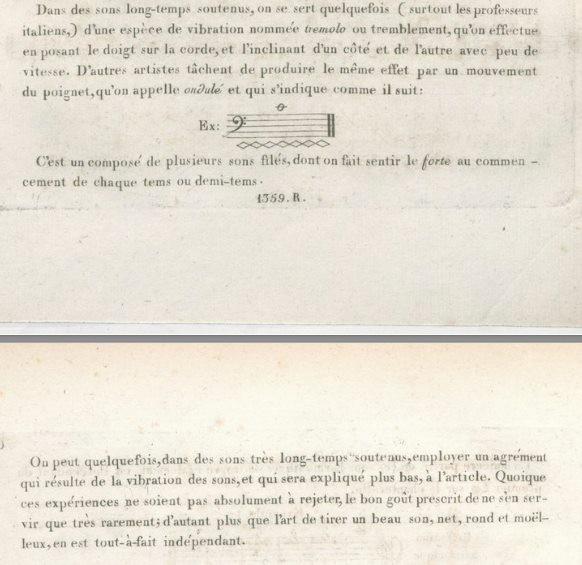
Dotzauer cello method (Schott, Mainz, 1838, page 39-40 of the Richault French edition)
In conclusion, all these great string players from the Romantic Era speak about the intonational vibrato in a way that leaves no doubt to its status as an ornament. It was to be applied quite infrequently, certainly by modern standards, and only in specific places. The vibrato seems generally to have been a bit tighter and slighter than the fashion is nowadays. It was used with great care, especially by violinists from the older ‘German’ school such as Joachim. The recordings from both the German and the French school also suggest an effect that is very much an ornament, rather than the modern tonal usage of it. Ysaye and Kreisler played an important role in the changing use of vibrato, coming from the Franco-Belgian school, both with an undeniably different sound, together with Ysaye, Hubay and Sarasate. Generally, one can say that vibrato was less important to string players in the Romantic Era than to string players today, and elements such as bowing technique, phrasing, accentuation, tempo and rhythm were more important to them.
For an informed way of performing Romantic repertoire, I would recommend to keep in mind the influence of Rousseau in the beginning of the 19th century. Often ‘Romantic’ repertoire is associated with a lot of passion, vibrato, suffering, emotions. Of course this can be the case, but the ideal in these days was to express it in a more innocent, direct and natural way. With a small vibrato in some consciously chosen spots, as an ornament. This in contrary with the flourishing ornamentation used in the late 18th century.
Some research is suggesting that continuous vibrato might be a direct result of recording performances. For sure, the dates do correspond. Here you can read more: http://www.charm.rhul.ac.uk/studies/chapters/chap5.html .
To end, here are three quotes from famous musicians who are commenting on this subject:
- Arnold Schoenberg (1945):
” Vibrato has degenerated into a mannerism just as intolerable as portamento-legato. Even though one may at times find the latter unavoidable, and admissible for purposes of lyrical expression, its almost incessant use even for intervals of a second is as reprehensible technically as from the point of view of taste. But I find it even worse the goat-like bleating used by so many instrumentalists to carry favor with the public. This bad habit is so general that one could begin to doubt one’s own judgment and taste, did not one occasionallyhave the pleasure, as I did recently, of finding oneself supported by a true artist. I listened on the radio to Pablo Casals playing the Dvořák Cello Concerto. Extremely sparing vibrato, exclusively to give life to long notes, and carried out with moderation, not too quickly, not too slowly, and without detriment to intonation. Never that sentimental portamento. Even intervals not easy for the left hand to join smoothly are bridged without adventitious help, simply by the artistry of his bowing. “
(Arnold Schoenberg, Style and Idea: Selected Writings of Arnold Schoenberg, edited by Leonard Stein, with translations by Leo Black (Berkeley and Los Angeles: University of California Press, 1984), 346.)
- Piatigorsky, to his brother Alexander, after being in the jury of the Tchaikovsky Competition:

(Terry King, Gregor Piatigorsky: The Life and Career of the Virtuoso cellist (McFarland, 2010), 261.)
3. Saint-Sains, on vibrato in his violin concerto (from a report of a lecture given by Saint- Saëns, 1915):

Sources:
- Geminiani, (1751). The Art of Playing on the Violin
- Galeazzi, (1790). Elementi
- Baillot et al, (1803). Methode de violin
- Winram, (1908). Violin Playing and Violin Adjustment
- Spohr, (1832). Violinschule
- Charles de Beriot, (1858). Methode
- Joachim and Moser, (1905). Violinschule
- Leopold Auer, (1921). Violin Playing as I teach it. London.
- Carl Flesch, (1957). Memoirs
- Boyden, D.D. (1965). The History of Violin Playing from Its Origins to 1761. London: Oxford University Press
- ‘The censored Publications of The Art of Playing the Violin’, Early Music, 11 (1983), 71-6
- Brown, C. (1999). Classical & Romantic performance Practise 1750 – 1900 London: Oxford University Press
- Milson, D. (2003). Theory and Practice in Late Nineteenth-Century Violin Performance, Ashgate
Esther Visser
Esther Visser is a Dutch violinist, specialized in historically informed performance practice. Directly after gaining her Bachelor of Music Degree in the Netherlands she was invited to continue her studies with Vilmos Szabadi at the Franz Liszt Academy in Budapest, where she completed a 3 year Postgraduate program. Simultaneously, she followed a 2 year program ‘Formation Superieure’ with the Orchestre des Champs-Elysées in France. She was coached by the concertmaster of the orchestra, Alessandro Moccia, and performed at the ‘Spotlight on Young Artists’ concert series of the Festival de Saintes. She subsequently gained her Master of Music degree for baroque violin with Sigiswald Kuijken in Brussels.
Esther acted as a concertmaster at several orchestras and during two years she was leader in the European Philharmonic Orchestra. She worked a.o. at the Netherlands Chamber Orchestra and the Arnhem Philharmonic Orchestra. Esther performed as a soloist with orchestras in The Netherlands, Belgium, France and Finland. As a baroque violinist she collaborates in concerts and CD recordings a.o. with La Petite Bande, Collegium Musicum The Hague, Concerto d’Amsterdam, and Musica Aeterna.
Esther is founder and artistic leader of ensemble La Chambre du Roi, winning the title ‘Promising Ensemble’ at the International Young Artist Presentation in Antwerp. She received prizes and study grants from the SNS REAAL Fonds, the Marti Keuning Eckhardt Stichting and the Ben Remkes Cultuurfonds. During 3 summers she participated at the Aspen Music festival, USA. Esther did practical artistic research on authentic performance practice of Romantic repertoire at Leuven University, winning the ‘Excellence Prize’ from the Roger Dillemans Foundation Belgium for this research. Since 2019 Esther is doing PhD research through the Canterbury Christ Church University (UK), researching the way how violinists supported their violin between 1790-1830 and the implications of that on performance practice and health.
Esther works as a guest lecturer at Codarts, Rotterdam Conservatory, and the Royal Conservatoire in The Hague as a specialist in historically informed performance practice. She also works as a guest lecturer at Canterbury Christ Church University (UK).

